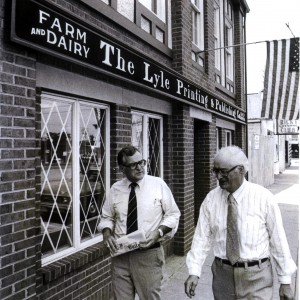The year I started at Farm and Dairy — 1985 — Coca-Cola attempted to change its 99-year-old formula to attract younger drinkers.
Anyone remember “New” Coke? Didn’t think so.
Seventy-nine days after its vaunted introduction, the new formula was discontinued and the company reintroduced the original Coke, proving once again, “if it ain’t broke, don’t fix it.”
When I started at Farm and Dairy, I wrote my stories on a typewriter, XXX-ing out paragraph after paragraph, and ripping unacceptable page after unacceptable page out of the carriage. After I typed it, I doctored up my copy with proofreader marks, carried it to a typesetter in our composition department, who had to type it into a phototypesetter.
The photographic paper with my story would then be fed into a processor, a machine that would pull the paper or film strip through two or three baths of chemicals, where it would emerge ready for paste up.
We trimmed those strips of type into our paper’s column widths, ran the paper through a waxer where hot wax (I’m talkin’ burned fingers hot) coated the one side. Then we wielded a razor-sharp X-acto knife and handled roller (think rolling pin) to place the sticky paper strips onto pages. Story too long? I changed commas into periods and forged new paragraph indents with the slice of a knife.
And don’t even get me started on what we had to do with photographs.
My abridged newspaper production history lesson has this moral: Some things need a new way of doing things. I, for one, would NOT go back to that production method, even if you paid me. We needed to change to become more efficient, and to improve the quality of the paper for you, our readers.
Celebrating one’s 100th year in business, as Farm and Dairy is doing in 2014, gives an opportunity to look back — to see just how far you’ve come. Within the company, we’ve had a lot of fun digging up our old issues and seeing your old farm photos. It’s nostalgic to look back, and gives us a sense of place, of history, of purpose.

With this issue, we’re starting a 10-week series featuring farms in our circulation area that have us beat — we’re spotlighting working farms that have been in the same family for 200 or more years.
At first, we thought we’d focus on farms that have been in business as long as we have, 100 years. But then we discovered there are a significant number of Century Farms (which is truly awe-inspiring!), so we turned our sights to Bicentennial Farms.
Two hundred years. One family.
Amazing.
Our first family, the Schumakers, traces their Coshocton County farm to 1806. Think of all the changes those generations witnessed — McCormick’s first grain harvester (1831) and John Deere’s patented steel plow a few years later (1837); new soil fertility methods and knowledge; railroads and refrigeration; Mendel’s genetics (1866) that paved the way for crop improvements; steam power; better nutrition and disease control; better breeding; electricity; tractors (tractors!); conservation practices; scientific advances; improved management techniques; yield improvements; computers for recordkeeping and monitoring crop prices; GPS technology that allows precision farming. And that’s just skimming the top.
All the while, it took sound management to keep the farm profitable. Hard work. Tough decisions. Progressive thinking.
The same was true here at Farm and Dairy. We almost didn’t survive the Great Depression, but thanks to the business savvy of J.T. (Tom) Darling, grandfather of current owners Tom and Scot Darling, we’re here to celebrate our first century.
As romantic as the past may seem some days, we can’t go back, nor should we want to. It may be a cliche, but truly, I think the best is yet to come. In fact, I wish I was 21 again, for I’ve never seen such an exciting time to be part of agriculture.
A plan — a change — may flop, just like the “new Coke.” But Coca-Cola uncovered a new lesson from that failure, and it wasn’t “if it ain’t broke, don’t fix it.”
“… the most significant result of ‘new Coke’ by far,” then chairman and chief executive officer Roberto Goizueta said in 1995 at a special event honoring the 10-year anniversary of new Coke, “was that it sent an incredibly powerful signal … a signal that we really were ready to do whatever was necessary to build value for the owners of our business.”
A willingness to change.
Here’s to our next 100 years.
————–
By SUSAN CROWELL
editor@farmanddairy.com
STAY INFORMED. SIGN UP!
Up-to-date agriculture news in your inbox!












